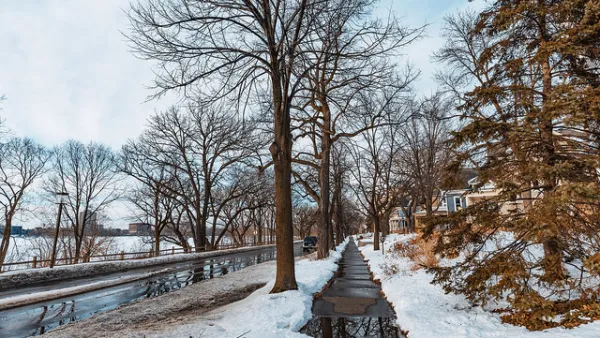Americans are living longer and changing the demographic profiles of our cities in the process. Planners are just beginning to understand how our streets and systems must adapt to accommodate this trend.
Did you know that crosswalks timers assume that people walk at about 4 feet per second? Most 80-year-olds don't move at that pace; just one illustration of why most places are "woefully unprepared" for an aging America.
"As Richard Florida reminded us last week, 10,000 baby boomers will turn 65 every day between now and 2031," notes Emily Badger. "By then, one in five people living in America will be older than 65. Crosswalks are only one piece of a deep-rooted problem composed of many subtle environmental details most of us never even notice: Is there a park bench to catch your breath? How about a curb cut for your walker?"
"Cities everywhere need to begin recalibrating for this moment now (a better crosswalk speed, for instance, would be closer to 3 feet per second)," she explains. "But this generational age bomb is also arriving at precisely the worst moment to pay for those changes that will actually cost money. And then there is the problem of imagination: How do you get urban planners, transportation engineers, and anyone running around a city in their prime to picture the places where we live through the shaded eyes of an octogenarian?"
"Age-proofing cities will be a cultural challenge as much as an urban design one."
FULL STORY: The Next Big Infrastructure Crisis? Age-Proofing Our Streets

National Parks Layoffs Will Cause Communities to Lose Billions
Thousands of essential park workers were laid off this week, just before the busy spring break season.

Retro-silient?: America’s First “Eco-burb,” The Woodlands Turns 50
A master-planned community north of Houston offers lessons on green infrastructure and resilient design, but falls short of its founder’s lofty affordability and walkability goals.

Delivering for America Plan Will Downgrade Mail Service in at Least 49.5 Percent of Zip Codes
Republican and Democrat lawmakers criticize the plan for its disproportionate negative impact on rural communities.

Test News Post 1
This is a summary

Test News Headline 46
Test for the image on the front page.

Balancing Bombs and Butterflies: How the National Guard Protects a Rare Species
The National Guard at Fort Indiantown Gap uses GIS technology and land management strategies to balance military training with conservation efforts, ensuring the survival of the rare eastern regal fritillary butterfly.
Urban Design for Planners 1: Software Tools
This six-course series explores essential urban design concepts using open source software and equips planners with the tools they need to participate fully in the urban design process.
Planning for Universal Design
Learn the tools for implementing Universal Design in planning regulations.
EMC Planning Group, Inc.
Planetizen
Planetizen
Mpact (formerly Rail~Volution)
Great Falls Development Authority, Inc.
HUDs Office of Policy Development and Research
NYU Wagner Graduate School of Public Service





























